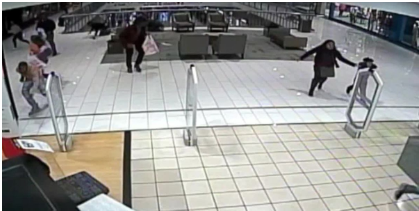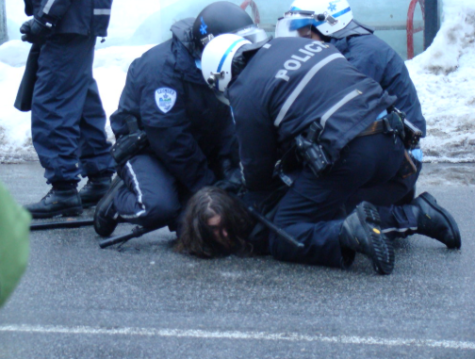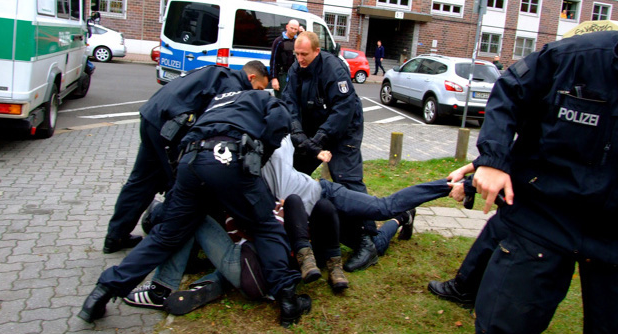Our youth is in danger
June 17, 2019
To become a police officer, it takes courage and responsibility. Every day countless officers are putting themselves in dangerous situations to protect and save the lives of others. However, the danger may just be the police. Police brutality and corrupt cop issues have increasingly risen.
When faced with a life or death position, guns and other tools may be necessary, but using these tools when there is no danger is known as police brutality. Police brutality is one of the several forms of police misconduct, which involves undue violence by police members.
Social media like Instagram, Facebook and Snapchat mostly target young people of today’s society. These certain post can set a certain “look” for minorities and can possibly create stereotypes for police. These stereotypes can come of as threatening and potentially be the cause of a serious situation. Those it may not cause brutality, it can set minorities in trouble.
An interview conducted by the newsone.com included what a cop had to say about the race relations at the NYPD, “I have to say that race relations are (believe it or not) good. If anything, the only thing I could comment on is that some officers believe there is a certain ‘look’ that most perpetrators have and that tends to be those who follow the trends of urban Hip Hop culture. That would consist of cornrows, sagging jeans, earrings, fitted caps, etc. So, if a cop fits this mold in his civilian clothes, they often joke ‘you look like a perp.’ I believe some of them try to mask it behind a few smiles, but they really believe that. Though, many do fit this ‘profile’, at least in the communities I’ve worked in, it’s still an unfair generalization.”
This judgement made by some police shows the discriminatory thoughts that take place, which could eventually lead up to death.
Nakai Mitchell, Junior at Henry County High School, had a lot to say about this, “When I saw this I thought it was crazy how there’s more white people in the United States who are being killed by the police when in media, you usually see more black people being abused and killed.” This proves just how the media displays incidents.
New technology such as phones it is easy to say “Police brutality in the United States is not worse. Phones and social media just make it feel that way.” But it’s a lie. According to Shaun King , “There have been more police killings thus far this year than in the same timespan in any of the last five years. That means the problem is getting worse. It doesn’t just feel worse. It’s not just the cameras and the hashtags. It’s actually getting worse.”
As more and more videos surface the news, police brutality is becoming more known but the problem isn’t getting resolved. Over time, “Police are using lethal force even more than in 2014. It hasn’t slowed down — it has sped up” said King.
In New Jersey, on March 16 a transit cop was caught on video outside a Trenton train station, “dragging an apparently unconscious man and punching him in the head outside a Trenton train station.” The officer was seen throwing the man on the ground and yelled “Get up and get out now.” Though it is unclear from the video what the issue was, this form of violence is not acceptable. Situations similar to this, come out with a worse outcome.
EJ Bradford was one of the many victims who was killed by police. On Thanksgiving night, Wilson and his friend were at a mall to do some Christmas shopping when the shooting happened. Brian Wilson, 18, and a 12-year-old bystander were injured in the incident. However, “Bradford was fatally shot by a Hoover police officer after shots rang out in the Riverchase Galleria mall. The day after the shooting, police said Bradford was likely not the person who fired the shots that injured the other two.”

Reporting after the officer shot Bradford, he and one other officers approached Bradford’s body and made a fist-bump gesture. There was no attempt to render first aid before this gesture. Bradford was an innocent man who along with many others sadly were falsely accused and as a result, died.
Many other incidents like this have also been caught on camera.
One of the most famous police brutality case occurred on March 7,1991, a video was released showing police officers beating, kicking and clubbing a 25 year old black man. The man named Rodney King had just pulled over when 3 officers started to beat him with clubs.
These small minority of officers who abuse their privilege are the reason for the continuous number of deaths in America by police that keeps rising.
All throughout history there has been countless reports of killings and homicides of innocent citizens most of which are young people of color.
Ms.Klimowicz, a teacher at NYC iSchool stated, “The first thing that pops into my head [when hearing the words ‘police brutality’] is all of the cases or examples of young people, especially when people of color who have been shot or killed because of police misinterpreting a situation. These are largely and it’s individuals who do not deserve to be treated the way they are and police in general carry a lot of power and that power is being abused especially in situations with young people of color.”
According to Vittana, “84% of police officers have stated in a recent survey that they have directly witnesses a fellow officer using more force than was necessary.” This act of additional force is usually drawn by the race relations in society and social media.
In the streets of New York, a few questions were asked. One of which measured the different viewpoints many New Yorkers had. The question asked was when is it okay to use deadly force. Many had lots to say.
David Gomez, 16, stated, “To me, it’s only okay to use deadly force if the person being stopped has a weapon or is like threatening the cop saying they gonna kill them or something but other then that it’s not okay.” Many others had to agree with David. However, Jared Martin said the opposite, “Honestly, the police should be able to go to any force if they feel is necessary. The police knows what’s right and they have the power to do so.”
A common idea that New Yorkers brought upon was the danger of the person affects how the situation will turn out. Commonly, police will only purpose force if there is a crisis but unfortunately this wasn’t the case for Dallas officer Amber Guyger.
The ytimes.com reported, “After completing her shift on Thursday, the officer went to her apartment building across the street from the Dallas Police Department’s headquarters shortly before 10 p.m. But the officer, who was still in a police uniform, did not go to her own unit and instead tried to enter the residence of a neighbor, Botham Shem Jean. She then shot him, the authorities said.”
It was unclear whether the door was locked and why Guyger started shooting or how she had mistaken it for her apartment unit. Nonetheless, he was shot and killed.
Although people of color appear to encounter misconduct, statistics show different. According to Washington Post, out of the 992 people who were shot and killed by police in 2018, 452 people were white compared to the 229 people who were black. This doesn’t specify the cases of police misconduct or any case in general. Most of these killings could be reasonable.
Hg.org remarks black males are more likely to be in these situations: “while white people may have represented more numeric deaths in police killings, blacks make up a disproportionate share of these deaths. While Caucasians represent about 63 percent of the United States population, blacks make up about 14 percent of the United States population. Nonetheless, in some years, blacks have accounted for more than a quarter of victims of police shootings despite the lower percentage of the total population they represent.”
From the outside view looking in, the training and policies that police are using is no good. Countlessly every year innocent people are dying in the hands of police, yet police have said no word until an interview appeared.
In a recent interview with Raymond E. Foster, he explained, “Being a cop was all I ever wanted to do.” Over many years of work, Foster, “would look at [police brutality] and go, ‘Oh, yeah, now I know why that happens.’ Because I had seen it happen so many times in my career.’”
He explained, “First starting off, every day is very different and every situation you’re called upon to take charge and solve those problems, that’s the most fun you can have.” Despite this, “being in the workforce for time, some can get greedy for power and they can start to abusive the power they have which is ultimately the cause of police brutality.”
A report published in nytimes concluded “that when police officers in the United States kill unarmed black people, it damages the mental health of black Americans living in those states. The mental health of white Americans was not similarly affected, the researchers found. Nor were negative health effects associated with police killings of unarmed white Americans or armed black Americans.” Unarmed Black Americans all throughout the US have all grown fear for police officers, a fear which should never occur. These mass killings not only affect the families who the ones killed but also those who could be in that same position.
According to Hg.org, “Law enforcement officers who are already concerned about their safety on the job may be even more anxious when confronting individuals who they prematurely perceive as violent or criminal.” This is often brought up by stereotypes mostly stating that blacks are more violent than others, and this image is often replicated in media. Throughout social media, it is believed that “certain minorities are more likely to engage in criminal activity than others.” Racial stereotypes are only part of the problem that leads to police brutality.
Though police brutality is surfaced on news and social media, these issues also happen behind closed doors. A young woman named Witlee Ethan came out on rehumanizeintl.org as a victim saying, “When I went to break up with him […] he got angry; he pushed me back in a corner of his house forcing me into a police hold … and sprained my wrist.” Arriving the hospital, she was refused care by medical staff. She filed all the official medical documents confirming she had been a victim of domestic violence. But this was not enough. “He was protected,” says Witlee, “and had privileges” outside the law because of the ‘blue code of silence”.
This ‘blue code of silence’ is a strong positive friendship that exists to protect and not report on a colleague’s crimes, misconduct or errors. With these codes, it is nearly impossible for cases like Witlee’s to fall through the cracks and be pushed aside.
Ms. Wright, an 8th grade teacher at TEP Charter School stated, “I think if we drastically train to change how policing is done in the United States. I think that we could see some changes.”
Recently, there was a shocking video released showing New Jersey cops repeating choking and punching a teenager who is on the ground. Witness and friend Marcus Robinson who recorded the video told the nypost.com, “He couldn’t move his arms, but then they were saying ‘stop resisting’ at the same time. And then they started punching him. I thought bro was going to die.”
Though Luke was charged with assault and criminal mischief. This type of force is not needed. Luke as seen in the video was being choked and even dragged around.
“I think that we definitely have to start thinking about how do you talk as a society about police brutality and I do think that young people in particular should feel empowered to talk about those with adults in their communities,” Ms. Klimowicz said. “I don’t think it affects everyone the same. I think that it just proportionately effects poor black males and males of color in general.”
Today’s youth may have experienced these issues, so it’s important to talk about these topics.
The biggest discussions that divide the United States today is the debate on the right to bear arms. This amendment has been around since 1791 yet today there is so much complications that come with having guns. From eighteen year olds to police officer, too many people owning guns give a higher chance to more fatal and threatening problems.
Jerllyn Jimenez,19, spoke about what she thought about the Second Amendment,“People can misuse them. There’s less regulation around them, I think we misinterpreted the Constitution for what it means in 2019. I think that gun control is a really big problem in the United States. I think that maybe even gun control around policing like whether not police need weapons could be like an interesting thing as well. If police weren’t armed and I’m not saying all police but community-level police if they weren’t harmed I think that will change the kind of tactics that they will have to take in order to deal with issues that have escalated without actually leaving to death.”
This idea of community-based policing used to be around in the late 20th century. This was used to build bridges between law enforcement and minority populations. “Citizens are more likely to comply with police directives and the law because they see the police as more legitimate. These increases in legitimacy thus have the potential to reduce crime by increasing compliance behavior” according to cebcp.org.
Lindell Mejia, a student at Manhattan Center for Science and Mathematics said,“I think one of the really big changes that needs to happen is that we need to have police members that are from a particular community be the ones police in those communities. And I think until they we have police that are members of and like actual associated with a particular community know the members of that community, I don’t think we’ll see any changes in the way that police treat people.”
If this style of policing came back into today’s society, it would improve the brutality that is happening now and possibly improve the relationship between teens and police officers. Teens would experience less fear and overall have more confidence in cops.
Ms. Wright said,“Oh definitely, I think we live in a really intense climate for just like not only in terms of police but politically as well and so I think we seeing that no one’s doing anything about it and that’s something we should definitely do something about.”
Police brutality has been around for years and is still evident in many societies up to today. These brutalities have been mainly fostered by race and ethnicity.
According to Jaivan Burgos, freshman here at the iSchool, “Black and Hispanic kids are more likely to be stopped by a cop because of their looks than let’s say a white kid and it ain’t fair.” Though this is an opinion, statistics may prove this is correct.
According to 2016 study by the American Psychological Association, “colleagues reviewed data from 12 police departments and found that black residents were more often subjected to police force than white residents, even after adjusting for whether the person had been arrested for violent crimes.”
Police brutality has now come to a point in which it is about race. As a society, we should never allow people who have this much power get destructive and as a result ruin our society.

These police brutalities are mainly directed towards minority or vulnerable groups such as the youth, the poor, and the weak. It is true that the police officers use excessive force to apprehend suspects and protect themselves, but they have been using this force excessively and this should be stopped so as to protect the citizens and the police officers. It should also be noted that race can never be a proof of criminal behavior. It should not be considered as a factor when suspecting crimes.
Young adults and teens should never have to experience a situation where they barely escaped life. Police should have more regulation and build a better system. Police brutality is in fact getting worse and there needs to be more to help stop it.
Only way police brutality can be eliminated if the public and the police work together. The police efforts in stopping these brutalities can only be achieved through its administrative organization. For example the public officials regulating security should discard laws that inflict strict punishments to the people who file falsified complains against the police officers.
A freshman at the NYC iSchool, who wanted to remain anonymous stated, “I have never first hand experienced someone being falsely treated but I have seen a lot of videos about it but if police were just able to communicate to each other and maybe involve punishment, this problem wouldn’t continue to go up.”
This is because at times these laws act as a restriction to people who believe that they are really victims of brutality. Many people will be convicted of crimes if they allegations are not accepted and this is very dehumanizing. The police administration should also set up citizen review boards. These boards will give the citizens the opportunity to bring in their opinions and their definitions of excessive force into the review of the police conduct.
Other efforts that can be made to reduce police brutality will include the use of the police foot patrols, gene stones and the federal and local reforms as well as body cams on all cops and more integrity with cops.


